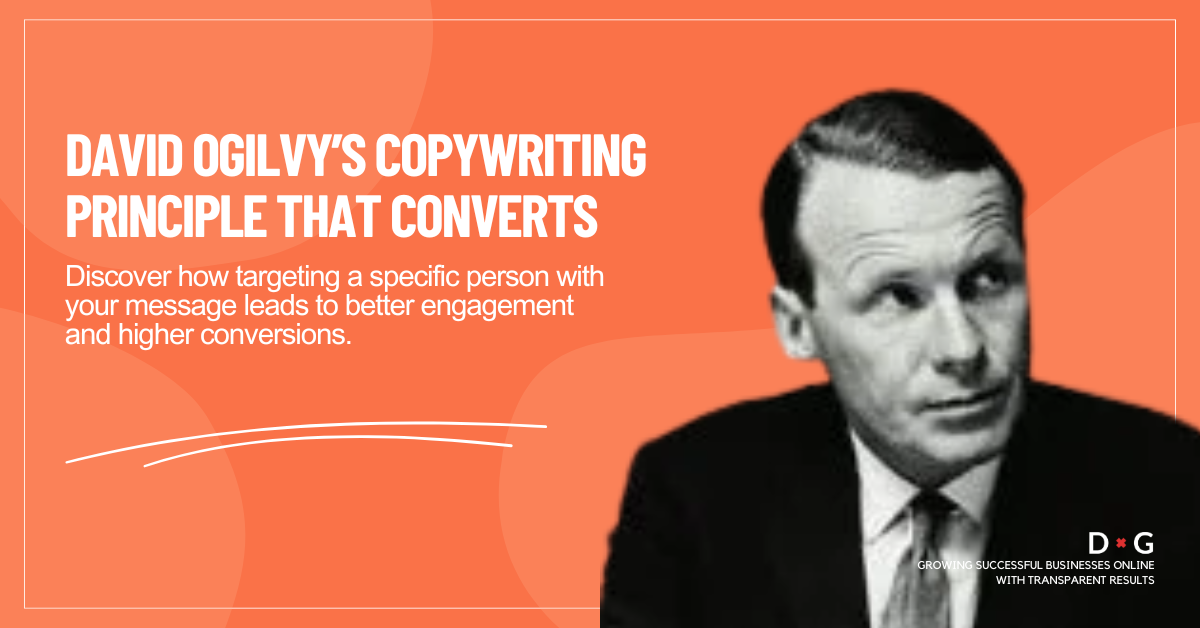
When it comes to writing copy that drives real results, one powerful idea stands out. It comes from advertising icon David Ogilvy:
“Do not address your readers as though they were gathered together in a stadium. When people read your copy, they are alone. Pretend you are writing to each of them a letter on behalf of your client.”
This is more than clever advice. It’s a copywriting principle that converts.
In today’s crowded digital landscape, your message must feel personal to make an impact. Broad, generic messaging rarely resonates. But when you speak directly to one person, addressing a specific problem at a specific moment, your copy becomes compelling, relevant, and persuasive.
Who Was David Ogilvy, and Why Listen to Him?
David Ogilvy is known as the “Father of Advertising”. He built some of the most iconic ad campaigns in history and founded the global agency Ogilvy & Mather (now Ogilvy).
What made Ogilvy stand out wasn’t just creativity; it was strategy. He believed good copywriting wasn’t about clever words, but about clear, direct communication that speaks to one person at a time.
The Power of Speaking to One Person
When people engage with your copy, they’re often alone, scrolling through their phone, reading an email, or browsing on a search engine. It’s a one-on-one moment. And your words need to speak directly to them.
That’s why your copy should feel like it was written just for them.
Let’s compare:
- Generic Copy: “We help businesses grow online”.
- Targeted Copy: “Are you a Brisbane cafe owner struggling to post on Instagram every day?”.
Which one makes you feel seen? The second, right? That’s because it follows the copywriting principle that converts: speak directly to one reader.
Niche Down to Connect Deeper
To “niche down” means narrowing your focus to a specific group of people. You’re shifting from broad appeal to targeted communication with a defined audience.
For example:
- Too Broad: “Our app is great for everyone”.
- Niche & Clear: “Busy tradies in Sydney use our app to track invoices in under 2 minutes”.
The second version doesn’t just describe what the app does it talks directly to the user and their problem. That makes it more effective.
By narrowing your message, you don’t lose reach, you gain relevance.
How to Write Copy That Converts
Let’s look at simple steps you can take to apply this principle in your own writing:
Know Your Reader
Create a persona:
- Name
- Job
- Pain points
- What they care about
This allows you to write as if you’re speaking to a real person directly and authentically.
Use Personal Language
Talk directly to the reader using “you,” not “our customers” or “business owners.” Make it feel like a one-on-one conversation.
Solve a Specific Problem
Your copy should focus on solving one key problem, not a long list of features or benefits.
Use the Right Tone
Think about how your reader talks and match that tone. If they’re casual, be casual. If they’re formal, adjust accordingly.
Be Clear, Not Clever
Clever headlines are fun, but clarity is king. Your reader should understand your message instantly.
Examples of Targeted Copy
Let’s look at two examples:
Good Copy:
“Struggling to fill seats at your Gold Coast yoga studio? Our booking system was built to help small fitness businesses like yours grow online.”
Bad Copy:
“We offer scheduling solutions for businesses of all sizes.”
The first speaks directly to a specific person, while the second is too vague to connect.
Brands like Mailchimp, Nike, and Canva often use this personalised approach. Their copy makes you feel like they know exactly who you are.
Why This Copywriting Principle Converts
Here’s why Ogilvy’s advice still works today:
- Builds trust – People respond when they feel understood.
- Grabs attention – Targeted messages cut through the noise.
- Increases conversions – A personalised message creates relevance, and relevance leads to higher engagement and conversion rates.
When you write for one person, your message becomes more focused, and that’s what makes it powerful.
Conclusion
David Ogilvy’s copywriting principle that converts is simple: Write as if you’re speaking to one person, not a crowd.
Cut through the noise with copy that’s sharp, straight, and speaks to someone, not everyone. Niche down your message. Understand your audience. And write like you’re having a conversation, not making a speech. That’s how you create copy that actually converts.
Want to explore how targeted messaging works in advertising? Check out our blog, What Types of Messaging in Paid Ads Work and Why?. It’s a great next step if you’re ready to apply David Ogilvy’s copywriting principles to your paid ad strategy.
